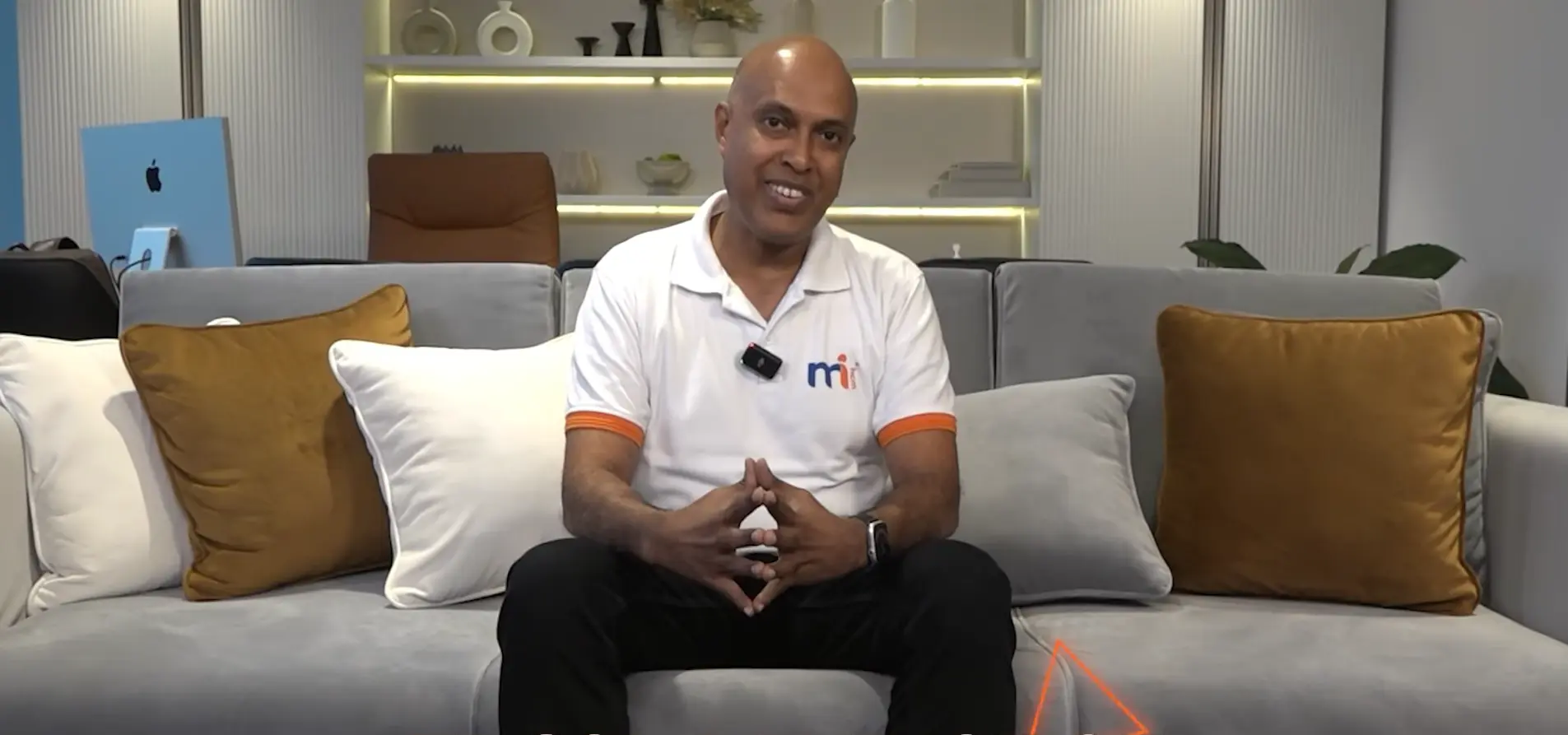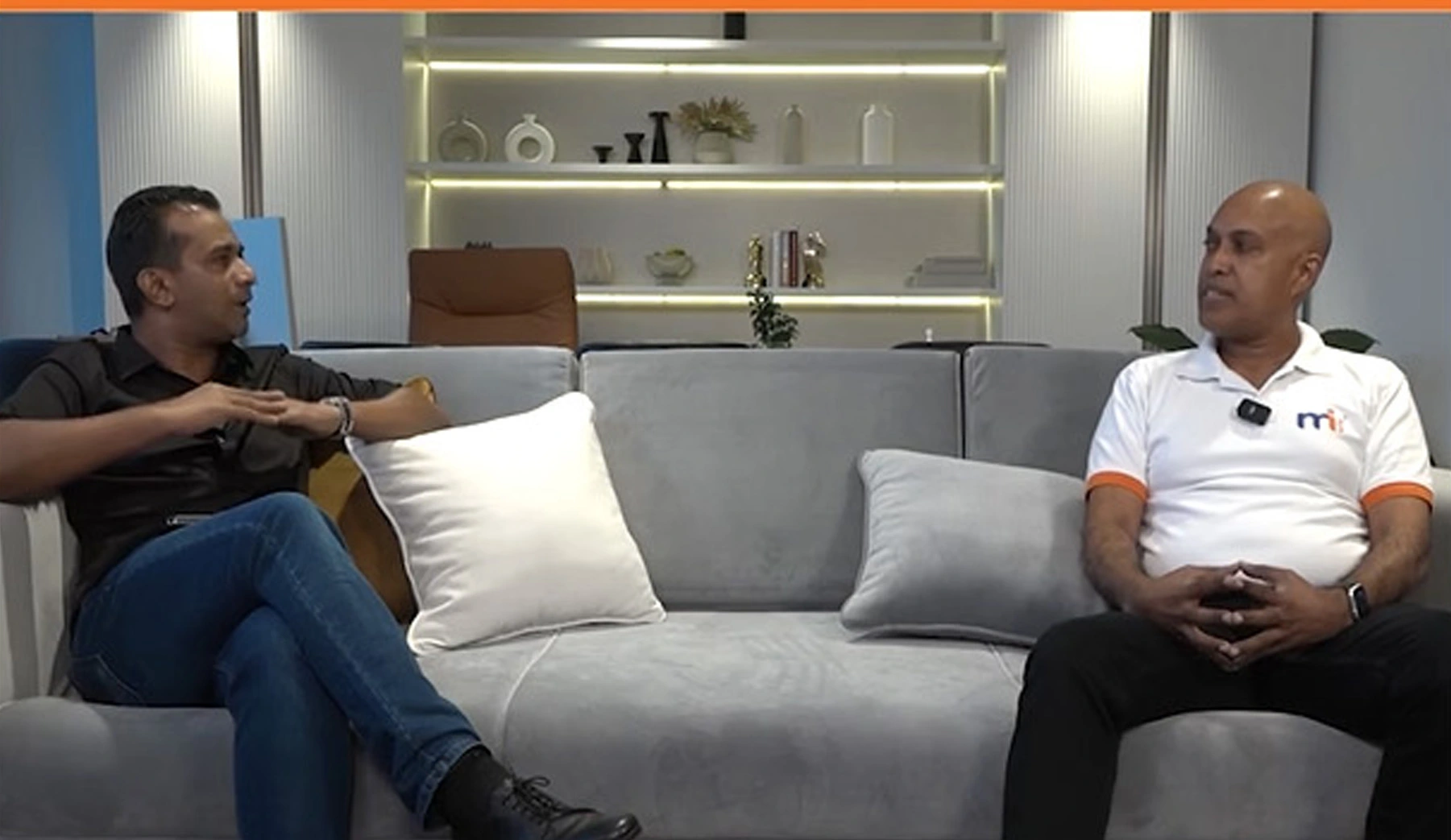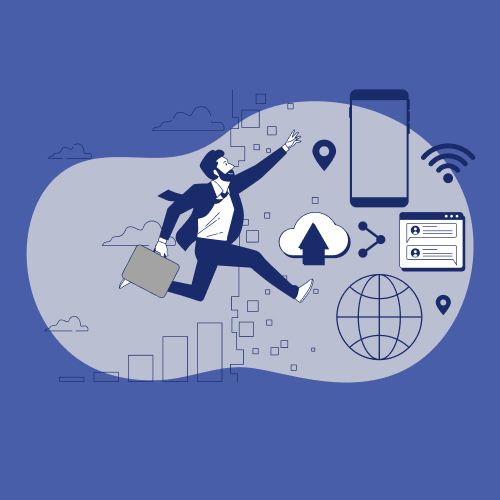
The pandemic disrupted traditional ways of working but also fast-tracked digital transformation worldwide.
MiHCM CEO Harsha Purasinghe shares insights into how MiHCM navigated this shift and helped businesses embrace the future of work, in this exclusive conversation with Shaq on the ‘Meet the Tech Titans’ podcast series by PodHUB Sri Lanka featuring influential voices in the tech industry, sponsored by Hutch Sri Lanka,
In the course of the interview, Harsha highlights the role of MiHCM’s AI-powered solutions, including MiA, in driving productivity and accountability for teams no matter where they work. From enabling seamless remote collaboration to ensuring workplace security, MiHCM continues to lead the way in transforming businesses.
Read the full interview below to learn more about:
- How digital transformation is reshaping the HR landscape
- The role of AI and automation in enhancing employee experiences
- Insights into leveraging data to drive smarter workforce decisions
- The future of HR in an increasingly tech-driven world
- How MiA, MiHCM’s “COVID baby,” is reshaping the workplace
The Microimage and MiHCM journey
Shaq: Lovely to have you on the show, Harsha. Obviously from where we started, so many different things under Microimage have changed drastically. You’ve expanded wings, you’re in different countries, your products are almost all over the world. Let’s start off by talking about MiHCM, which is what we’re going to be focusing on. MiHCM has established itself as a leader in digital HR solutions. Before you got into all that Harsha, how was your journey at Microimage?
Harsha: In short, Microimage, without any doubt, is the most successful high school startup from the ’90s. We started when there was no startup ecosystem, there was no big IT industry as such; this was in the mid-’90s. Straight out of school we built a product at that time.
The opportunity that we saw was the transition period from Microsoft DOS to Windows 3.1, so we built a bunch of Sinhala fonts. There was no internet, nothing. I was sharing the story the other day at the Global Entrepreneurship Week.
At that time my internet was the British Council Library, I would run there to read the books and figure things out. That’s how we learned. Then subsequently the internet came. That’s the era we started, from absolutely nothing, and built the multi-million-dollar business of today.
Microimage in that journey has transitioned into a holding company which holds MiHCM, which is our digital HR tech SAAS business. We have another company called Futura Technology Labs, which holds very interesting IP around broadcast media and digital services. That’s how things have transitioned. So straight out of school I’m still running this.
Why digital HR?

Shaq: That’s a fantastic story. Digital HR of all things in the world. Why did you go into digital HR?
Harsha: We’ve been doing HR software since the late ‘90s, starting with time attendance payroll software, then building the first web-based HR system back in the early 2000s.
The pivotal moment happened in 2013 when I visited the Gartner Catalyst in San Diego. I was listening to the opening keynote and the keynote speaker said social mobile cloud and analytics were going to disrupt the whole world. At the same time when I came back to San Francisco, the Uber and Airbnb experiences I had made me realise the underlying platform architecture was these forces.
At that time, I saw that the digital tsunami was going to erupt a few years later and we decided to build a complete digital HR platform to move all the old clunky legacy HR processes in every process, starting from simple things like absence/leave management to things like talent management, every experience needed to transition into a digital experience combining these key digital forces.
At that time AI was not even a big topic like today but the analytics, the mobility experience, moving to the cloud, and leveraging the power of insights were the key things. So why? It was a no-brainer that era was erupting, and we wanted to be at the forefront helping organisations transition from legacy human resources to digital.
That’s why we built a complete digital platform with a proper platform architecture which we can scale to many other countries beyond the country of origin. Now we are in 22 Asian countries, and we are planning to venture into the Pacific as well and to the ANZ zone in the near future.
How the pandemic accelerated digital transformation
Shaq: Now if you look at the pandemic, which we all went through four years ago, it also accelerated the adoption of hybrid work and it pushed corporates and companies to rethink their working models and their strategies. What key trends do you see that have emerged with the whole pandemic push? Before the pandemic really hit, corporates were sitting in their comfort zone, everyone was happy in their little bubble, and then here comes the pandemic and you’re forced to do something for certain companies that were still living with the legacy systems into taking that step into the unknown, uncharted waters, and it was completely alien to them. How has this helped them adapt and sort of move through seamlessly?
Harsha: I would say the pandemic accelerated people who were sitting comfortably with legacy platforms with on-premise systems to transition to digital because there’s no other way.
With people moving to remote work, how do you do stuff, how do you engage with the company? You can’t just connect to the on-premise servers at your workplace. The key trend we saw was how people immediately started moving to collaboration platforms like Zoom, Teams, and Google Meets. That was the immediate need.
Then how about accountability of your work? That’s why we built products like MiA, which is an intelligent agent which checks you in in the morning and checks you out in the evening. You can be anywhere in the world but at the end of the day it asks for what you accomplished for the day so we can continue to see how people are effectively contributing to work no matter where they are. We built MiA due to COVID, so I call it a COVID baby.
In terms of trends, I saw people move into collaboration, then push for cloud-based ERP systems and HCM systems like ours, and adapt cyber security tools. Security became a priority because it’s not like you are coming to your workplace which is a secure place, you are connecting from various locations, so how do you secure the whole work experience?
That’s the shift that happened and with that momentum, it’s a no-brainer that everybody’s transitioning to digital HR platforms now.
How automation is reshaping HR
Shaq: Automation of course is revolutionising industries and, as we can see with your system, HR is no exception. How is automation reshaping the whole process of HR, which was traditionally known to be a man-to-man sort of cluster? It’s Human Resources. Now the whole terminology of Human Resources seems a bit out of service when you have automation that’s substituting that human for ‘Human’ Resources. How has that taken off?
Harsha: Automation actually enables that human-to-human connection more, because automation will take care of all your mundane tasks, which people otherwise get bogged down to deal with, like processing payrolls to doing transfers, promotions, figuring out reports that they want to present to the management… that takes so much of time.
Automation eliminates all that manual work and even if you have a legacy sort of HR system, the way a legacy HR system delivers information is very different to a modern digital platform. When you get rid of all these mundane tasks, which are taken care of by the automation layer, you have more time to speak to people, to do real work, to figure out what upskilling/reskilling needs to happen, and how to bring the agility that is required for the organisation as HR professionals.
I think those are the priorities that people can focus on when automation takes care of all your mundane, day-to-day tasks. HR has transitioned into a much broader strategic role with automation.
Automation and employee engagement
Shaq: Now if you’re looking at HR per se, especially with your system of course, which has made it so much easier for many corporates to focus on their core business and what used to be taken care of by individuals because they were forced to do it is being done separately, one of the biggest stories that’s actually that’s up right now is how we are in the age of big data. HR analytics is something that is always up for debate, the pros and the cons at the end of the day. How is this becoming a pivotal role to improve employee engagement in corporate workplaces? One of the biggest issues that corporates are facing today is employee engagement. Gone are the days when we used to wake up in the morning and be excited to go to work because we want to make a change. Today that shift is the fact that you wake up in the morning and you have to go to work, otherwise you don’t get paid. There’s no engagement in corporates anymore. How is the system actually helping with employee engagement?
Harsha: It’s a very debatable topic and depends on the organisation culture and the mode of work that you have. Some companies have gone full-blown back to office, some are continuing hybrid, and some are completely remote. Different organisation cultures and the modes of operation matter when it comes to employee engagement, which, in my view, is something to do with the leadership and the culture that you have built more than the tools.
However, the tools can facilitate this. In companies like ours, we do interesting things like regular pulse surveys. MiA will also randomly ask me how I’m feeling today, and I can give my feedback. If I continuously give a negative feedback, it will send a signal to my team lead or my reporting person that it may be time to have a chat with me. With this we can see what the disconnect is between the individual and the organisation.
This is where technology can come in, especially for a large organisation if they are geographically dispersed and working in a remote and hybrid manner. These are the kind of tools which can bring that element in. The tools can do regular pulse surveys and figure out the pulse of the people. You can use this tool to improve engagement elements and figure out where the disconnect is and what more needs to be done to address it.
The other thing is communication. Digital technology and the tools can be used to constantly communicate things properly. For instance, let’s say there’s a communication that you need to deliver where employees are supposed to give their consent and say that they have read and understood it. In the good old days, you just sent it via email; you didn’t know how many people really read the email and whether they opened it and took any action about it.
The role of leadership in digital transformation
Shaq: What role does leadership play in fostering a culture that embraces digital transformation, especially in HR, from the companies that you worked with, not necessarily in Sri Lanka? Like we said, you’ve spread your wings, you’re in different parts. Leadership obviously embraces things and trends in different ways. How crucial is that?
Harsha: Absolutely crucial. The clear difference I’ve have seen is when it is C-suite leadership-led, the project has significant success, is faster to execute, and achieves full-blown transition because the leadership drives it; the leadership wants it and wants to see the complete transformation.
It’s not about just picking the best digital HCM product and asking a bunch of people to implement it; you need to give the expectation, you need to be part of that journey, because digital HR today is not just for the HR department, it is for the entire company. All the line managers, C-suite, employees – everybody will be part of a digital HCM project or product outcomes. Therefore, the C-suite needs to get involved.
It’s very important that leaders drive this, understanding each vital element of this whole platform and its capabilities and bringing in those experience in a phased-out road map based on what is priority to transition for them.
If engagement and performance are a priority, you bring those engagement and performance tools in. If managing the hybrid workplace, the time sheets, and complex rostering are the priorities, you automate that and transition from that. If your priority is to derive various insights out of data, say for a mature organisation, then that could be the thing.
In all these scenarios, leadership at the highest level plays a key role and when they just delegate this to the IT department and HR department and say ‘okay, you run it,’ with the sort of thinking that it’s just a project of the HR department or HR and IT combined, the full merits of that transformation won’t be achieved.
Digital transformation needs a mindset shift
Shaq: MiHCM is slowly but steadily moving into many different corporates but there are a lot of pushbacks. Why are there pushbacks? If there are so many advantages, if there are so many avenues where obviously your system or an HR automated system out there can take care of the mundane work and you get to concentrate on the core businesses, shouldn’t that actually be appealing to corporates?
Harsha: Resistance to change is one of the things. Any digital transformation project requires a huge mindset shift. It’s not only for HR; for any digital project, you need to really move out from your comfort zone, your status quo, and think differently, focusing on the future.
That’s where people are stuck because when people are comfortable with certain things, a certain way of work, they don’t want to shake things up. That’s the pushback we’ve seen in some cases. But what happens is, the outside pressure is enormous with digital now.
If you switch on the TV, if you go to social media, or you read news, AI is everywhere, so with all these things and when you see your consumer experiences changing, people slowly start thinking ‘this experience should come to work, we need to change our workplaces to experience what we experience in a consumer world’.
With these things happening, the external pressures are such that there’s no choice. People need to really figure things out and move forward.
There were a lot of pushbacks in the past. Pre-COVID it was very hard for to for us to convince people to move from on-premise legacy HR systems to cloud. Post-COVID, it accelerated; people were chasing us for digital HCM systems. Today actually the pushback is limited; even small businesses today want to automate and move on, which is a phenomena we are seeing in many markets now.
Misconceptions about digital HR systems
Shaq: What is the misconception that’s actually valid today in the market by implementing a digital HR system? One of the misconceptions I suppose is the fact that this could possibly take away an entire department and that means people are going to be losing jobs?
Harsha: They need to really get into that human element. If you digitise and transform your mundane processes, now you have more time to have one-on-ones or group chats and to align your organisation to the required business objectives. If the organisation is not agile, you cannot survive.
Today any company is facing many challenges – technology shifts, global geopolitical challenges, we are in a very volatile and very challenging environment. If people are stuck with old clunky processes and have no time to have a conversation with people, those companies are going to go down. People who are agile are aligning their people and building the right culture to move forward.
We see another interesting dynamic today: for the first time we see all generations working together. I’m sure you have noticed that we have Gen Z, Gen Y, Gen X, and even Baby Boomers in the workforce. With technology, people in their 60s and 70s are engaging in part-time work or gig work. There are different types of workers working together, with technology tools and bots helping our work.
As HR people you need to understand these societal changes and shifts in the way people work and spend more time building that rather than being stuck with old processes. It’s a very exciting time so you have to get out there and figure out what kind of upskilling or reskilling you need to do to ensure that you have the right skill sets in the organisation to face the future. That’s how I see that transition needs to happen.
Sri Lanka and HR automation adoption
Shaq: Now obviously you’ve got a presence in different parts of the world, and you also have a presence in Sri Lanka. Adaptability wise, how is Sri Lanka matching up to the rest of the world HR automation wise?
Harsha: I would say very good. Sri Lanka I’m very proud to say is ahead of the curve. Sri Lankans love to adapt and move on. If you look at all the corporates around us, the majority of them have a digital HCM in place and are now slowly implementing all the other things.
Four to five years ago, a lot of people were not ready to even adapt to mobile self-service. Mobility is enabling the self-service experience on mobile and other tools like chatbots are all happening here. Today Sri Lankan organisations are talking to us on AI and analytics stuff, which is very interesting.
Today they all get exposed to what’s happening out there. We can’t live in isolation so we are in a connected world and all our corporates want to be the best at their game, so they want to see that they use the best tools.
Adaptability is really good in the corporate sector, but SMEs have a long way to go. We have a lot of digitisation to happen in the SME sector compared to the likes of Singapore and Malaysia, which have a lot of incentives for SMEs to digitise, with many programmes in place. I’m pretty sure in time to come SMEs also will digitise operations.
How AI is shaping the role of HR
Shaq: What’s the next wave of technological advancements that you’re really excited about?
Harsha: I think how AI is going to shape the way we work and shape the role of HR is something I’m really excited about. This is something that I think about a lot these days because we have already built our own AI on top of our HCM platform – we were one of the first to do so in Asia.
We built our own HR co-pilot. With that we saw the kind of problems that we solved that we couldn’t solve before, even though we are a digital HR product. Within seconds we can do things like job descriptions to letters to survey templates to anything. You can just give a prompt, and it generates for you and then you can analyse the data within a flash after publishing and collecting that data.
On top of that, imagine giving that ChatGPT sort of experience to your own data where you can go and ask, ‘okay compare the top three performers and give me what kind of development plans I need to build?’ These is phenomenal stuff.
I’m very excited about how AI is going to reshape organisations and the function of HR and how these tools are going to help to hire people fast, upskill/reskill people, and how this technology can be used, because it’s inevitable that AI is going to come into all our lives, it’s already happening, so that’s the area that I’m very excited about from a technology point of view.
Harsha’s most interesting moment
Shaq: Harsha, obviously it’s been, as always, phenomenal to have a chat with you and find out all these fabulous things. Before we say goodbye, over the last few years with Microimage, the holding company, right now what is the one moment that stands out as a very rewarding moment in your life, that has a very soft spot and will always be there?
Harsha: The most interesting moment I would say came to me around 2013/’14, when I realised that we had built a very interesting company, but it was almost like a lifestyle company.
We had a particular revenue, we were doing a lot of innovative products, and the products were widely used by Sri Lankan companies, including people like you, who are customers for our Futura-based products, so why we can’t scale globally? What does it take for us to build a phenomenal global organisation?
I would say that was the most interesting transition point for me personally, as someone who has started with absolutely nothing, with no prior college degree, no mentors, or anything.
Everything I’ve done was self-taught, so trial and error with a lot of hardship, to figuring out how now that this journey has come to a sort of a lifestyle stage, how can we build a global organisation and compete with the best of the best and make an impact on the greater world?
I think that step enabled building the MiHCM platform and at the time we launched the MiHCM platform, in terms of global presence we had only about three countries. Today it’s in 20-plus markets, including markets that people don’t believe that you can even enter because it’s very challenging because of the localisations that you need to do – markets like Thailand, Vietnam, Indonesia… we are in all these markets today. Also, Myanmar and Cambodia, which are non-English speaking and have very different nuances.
I would say the most interesting moment in my life was when I had to think very big and transition my mindset to change how I look at things, to a bigger way rather than with a narrow focus.
Taking Sri Lanka to the world
Shaq: Well Harsha, it’s been an absolute pleasure to have you on the show, thank you so much for agreeing to be with us on the show ‘Meet the Tech Titans’.
It’s voices like Harsha Purasinghe, influential and iconic voices in the tech industry, who are taking Sri Lanka to the world and giving us all the fabulous insights in different expertise and different industries because the world of technology is massive.
Everybody owns a very, very small slice of the pie but the good thing of course is the fact that everyone needs to work together for the tech to work. That’s what we’re doing, meeting the ‘Tech Titans’ in Sri Lanka, giving you insights, and letting you know exactly where they are going and where they’re hoping to take Sri Lanka.
Watch Part 1 of the interview here.
Watch Part 2 of the interview here.



